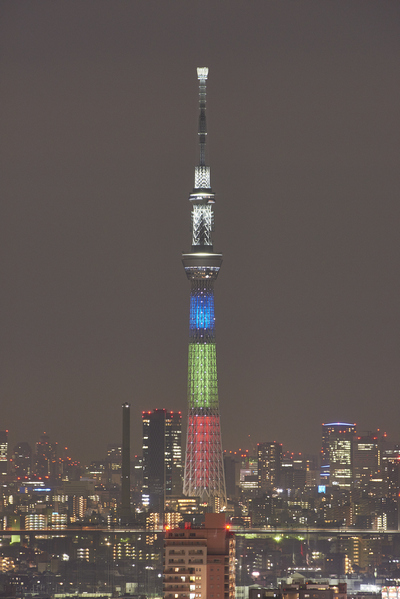For 8 days from December 11th (Thurs) to 18th (Thurs), 2014, the Tokyo Skytree run by Tobu Tower Skytree (Headquarters: Sumida Ward, Tokyo; President: Masaaki Ito) will be lit by a special lighting sequence, the "3 Primary Colors of Light" developed in collaboration with Panasonic Corporation to commemorate the Nobel Prize in Physics, which was awarded on December 10th (Wed) to 3 Japanese Nobel Laureates for the invention of blue LEDs.
The illumination of the Tokyo Skytree, entirely fitted with LEDs, has endeavored to convey the aesthetics of Japan and the history of the area as well as communal ties. It also serves as a symbol of the times. Moreover, with its energy-saving performance, it is contributing to the conservation of the global environment.
 |
|
Tokyo Skytree brightens up ahead of Christmas. (Panasonic/LEDinside) |
The special lighting sequence featuring 3 primary colors (red, green, and blue) has been brought to life by the birth of blue LEDs, which has contributed to the commercial viability of a wide range of LED lighting fixtures and to saving energy. The lighting sequence features these 3 primary colors, and a beautiful design that comes to life when these 3 colors interact.
[Live Recorded] Tokyo Sky Tree(R) + Panasonic Special LED Illumination
http://ch.panasonic.net/jp/contents/14634/
https://www.youtube.com/watch?v=RQFLxYoTUbE
Tokyo Skytree - Special Lighting Sequence
Date: December 11 (Thurs) - 18 (Thurs), 2014; 20:15 to 23:00
The Tokyo Skytree will feature Christmas lighting until 20:15
TOKYO SKYTREE(R) Access: http://www.tokyo-skytree.jp/en/access/
To serve as a new symbol of the times, the Tokyo Skytree selected LED lights as its only light source, which at the time of the tower's construction, was not yet widely adopted. It is equipped with 1,995 LED lighting fixtures and a LED control system that can manipulate these lights at very high speeds.
LEDs have contributed to significantly saving energy during the nightly illumination (in comparison to traditional light sources, with the "Iki" lighting style, energy savings of approximately 43% and with "Miyabi" approximately 38%*1 can be achieved). LED technology has also brought to life a wide range of lighting sequences (22 different sequences).












